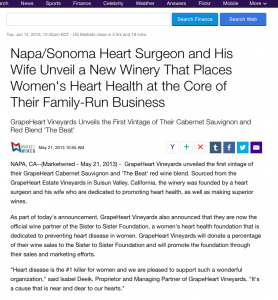 Napa/Sonoma Heart Surgeon and His Wife Unveil a New Winery That Places Women’s Heart Health at the Core of Their Family-Run Business
Napa/Sonoma Heart Surgeon and His Wife Unveil a New Winery That Places Women’s Heart Health at the Core of Their Family-Run Business
GrapeHeart Vineyards unveiled the first vintage of their GrapeHeart Cabernet Sauvignon and ‘The Beat’ red wine blend. Sourced from the GrapeHeart Estate Vineyards in Suisun Valley, California, the winery was founded by a heart surgeon and his wife who are dedicated to promoting heart health, as well as making superior wines.
As part of today’s announcement, GrapeHeart Vineyards also announced that they are now the official wine partner of the Sister to Sister Foundation, a women’s heart health foundation that is dedicated to preventing heart disease in women. GrapeHeart Vineyards will donate a percentage of their wine sales to the Sister to Sister Foundation and will promote the foundation through their sales and marketing efforts.
“Heart disease is the #1 killer for women and we are pleased to support such a wonderful organization,” said Isabel Deeik, Proprietor and Managing Partner of GrapeHeart Vineyards. “It’s a cause that is near and dear to our hearts.”
“Quality is essential and is never an accident, whether it’s in heart surgery or wine crafting,” said Dr. Ramzi Deeik, Proprietor of GrapeHeart Vineyards. “My wife and I started this project committed to doing the very best and we feel our first vintage is a reflection of our team’s hard work and dedication.”
The GrapeHeart Estate is located in the Suisun Valley AVA, a unique eight miles long valley Southeast of Napa. GrapeHeart Vineyards sits on 40 acres, backing up to the base of the southwestern slope of the Mt George Range. This location makes for optimal growing conditions for balanced, elegant wines that offer a distinctive sense of place.
About GrapeHeart Vineyards
GrapeHeart Vineyards is a limited production, family-owned winery owned by a Napa/Sonoma heart surgeon, Ramzi Deeik and his wife, Isabel. GrapeHeart makes elegant Cabernet Sauvignon wines and red blends in Napa.
http://finance.yahoo.com/news/napa-sonoma-heart-surgeon-wife-145513477.html


 How much do you really know about your heart’s health? It’s easy to be fooled by misconceptions. After all, heart disease only happens to your elderly neighbor or to your fried food-loving uncle, right? Or do you know the real truth – that
How much do you really know about your heart’s health? It’s easy to be fooled by misconceptions. After all, heart disease only happens to your elderly neighbor or to your fried food-loving uncle, right? Or do you know the real truth – that